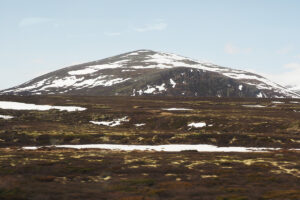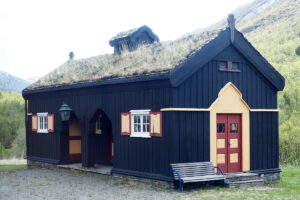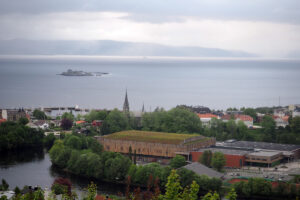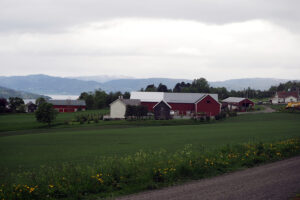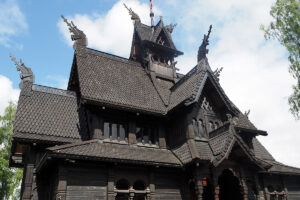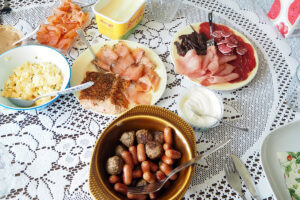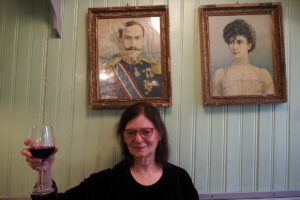Monday, June 5
Icelandair KEF > OSL
Sjøgata 4, Oslo
Carla Harryman
Travel consists in the denial of any goal for travel. Often one travels from point A to point B, but the experience of travel is otherwise than reaching the destination. This is why, for agéd traveler William S. Burroughs, “It is not necessary to live; it is only necessary to travel.” An interstitial space, the Interzone, the in between points of origin or destination, with the sensation of and material means for movement. One can become addicted to travel. Moving from a point of origin, it is often impossible to discern where that is—the “mooring of starting out” John Ashbery recalled as a condition of his availability at the outset, wherever that may be. We certainly did not begin our travels in Rochester, N.Y., though we passed by there recently on return from celebrating Ashbery with his tribe. One can adapt the field of aesthetic experience to the road map of travel and its discontents. Thus the rental car outside our hotel in Reykjavík must be returned directly to the scrappy terminal at Keflavík, site of former American airbase built on bare lava fields, roughly an hours drive south. The difficulty of locating the final gas station turned into a near catastrophe, but was masterfully overcome. Our transition continued through ticketing kiosks, baggage drops, crowded spaces, and passport checks where a border official tried to personalize each succeeding applicant before giving them a stamp. Once in the air it was normal, or anxious, or asleep. Then out the window the clouds parted and we saw the Farœ Islands, now the destination of a lifetime, soon to be passed by. After an intermission of blank time the massive coastal ranges of Norway loomed, with substantial snow cover, frightening in their immensity and lack of any habitation. The dramatic muscularity of glaciated ranges and valleys resolved into a flat plane of arrival and modern transit
to an overpriced and inconvenient city and its arranged destination for one night. Whose amenities were mainly its proximity to the renovated harbor zone where one could find something to eat at a substantial price.
Tuesday, June 6
SJ Norge Oslo > Trondheim
Lillegårdsbakken 33, Trondheim
“What does not change / is the will to change.” As I begin to write this account of my return to the North, where I have never been, that line pops into mind. Olson’s dictum itself has a transformative history, being used beyond its original scope by Adrienne Rich and bell hooks, as a conversation with poet Ann Lauterbach established in turn. If there is such a thing as in idée fixe, it will need to be addressed—even if takes until the end of time. Somewhere the charge is written that an idealization must be overcome, the prejudices one maintains for as long as one can know. Or not know, as the evidence of the Norwegian landscape, incrementally unfolding from station to station on our pleasantly timed trip, was beginning to prove. This is so like what I could not have imagined that I already knew it, would be a way of putting things. The train follows a lengthy waterway northward from the Oslo suburbs, climbing steadily, crossing occasionally, as the elevation increases. Now we are in a terrain of moderate partly snow-covered peaks seen out the window, with occasional way stations in nineteenth-century style. One wonders at the economy that established each station at this location and not any other. All human history must be like that—the arbitrary location that becomes a fixity. For Olson, this fixity was tragedy itself, the stasis of culture founded on the original act of displacement, which is now forgotten. Going back to the point of departure, the elevation decreases and we come into the outer zones of a city I have heard of for my entire life, confused with where now are.
Its presentation could not be more homely but unlike: painted wood bungalows in flat red, orange, green line a cobblestone street, leading down to the town with its student cafés and gentrified warehouses. We have an arrangement to meet.
Sigurd Viken
Heidi Viken
I have been away, I have kept away. Catching up with my family history is not an innocent pastime but has been arrived at over increments of decades. My sisters know what I am talking about, I am not sure I am going put it all in writing. My sisters have all visited at prior times, making friends with our relations and kin, while I, due to the right of primogeniture I am sure, have been last. Sigurd Viken is my second cousin; we share a common ancestor in our great-grandfather Nils, who with his wife Bergithe established a family of six. There is a story to be told, that will be told in due time. We are on time for our arrangement to meet. My opening line is prepared: “I’m back!,” channeling our common relation in Henrik Watten, son of Nils, my grandfather who emigrated to America about 1910 and vowed never to return.
The prodigal son must be in my genetic material, at least on that side. We introduce each other—Sigurd, Heidi, Carla, Barrett—and sit down for a meal of Norwegian sushi buffet. Students from the nearby technical university, which made Trondheim a center for electronics and computers, like this place. Sigurd and Heidi have both worked in the tech sector—Sigurd in radio electronics, Heidi in geological mapping. They are people who know how to do things at a level of technical skill. After our meal, we cross over the bridge with its postcard vista of warehouses on the river, to Trondheim’s major cultural edifice, Nidaros Cathedral. Reading its history now, I note that it is the northernmost medieval cathedral, founded by the king and later saint Olaf in 1070; that it is site of investiture of the Norwegian kings; and that it has partly and then wholly burned down several times, resulting in continuous reconstruction, extending to the present. I also learned that Norwegian Black Metal band Mayhem was obsessed with the cathedral and possibly conspired to blow it up, a satanic plot.
Visiting the cathedral in real time, I noted the modernity of its Adam and Eve, and wondered how the sexual proclivity of our first parents could have survived the institution of religion. Paraphrase is not destiny; how would William Blake have put it? The spirit emerges from stone and is frankly sexual. Another casting of spirit into stone was legible in a nearby statue to the Norwegian Resistance (a historical event in Trondheim), with its cast-down demon of Nazism depicted in bas relief under a resilient mother and child signifying Norway. Sigurd has just now sent a link explaining the outward face of the cathedral, where I learned that both Adam and Eve were sculpted from contemporary models in 2008—hence their freshness, which is a national allegory on its own. The promiscuous Eve and that serpent were my take-aways from the site, ever leading onward to know more:
“The serpent seduced Eve to eat of the tree of knowledge. . . . When the woman saw that the tree was good for food, and that it was pleasant to the eyes, and a tree to be desired to make one wise, she took of the fruit thereof, and did eat, and gave also unto her husband with her; and he did eat.” After taking in views from the surrounding hills of the fjord and outer islands, we retire to our cottage, with plans to visit the Watten environs in Agdenes (90 km west, about 90 minutes drive) in two days time.
Wednesday, June 7
> Byneset, Spongdal, Trondelag
Åse Iren Utness
Signe Anette Utness
Here I give credit to media and its mediation, as a way to reconnect family bonds (or discover them for the first time). I only knew my second cousin once removed Signe Utness from Facebook, where she kindly sent birthday wishes over the past several years—a general well wishing toward futurity. I had also received greetings from her aunt Anne and cousin Ann Theres, all unexpected, charming, and welcome—connected to information about what Norwegians do (outdoors; family), eat (of central importance), and wear (high fashion to farm clothes to traditional, depending on occasion). I was building a file of present thoughts and associations of Norway that were beginning to take over the monologue of national identity that, truth be told, seemed a stumbling block to any real contact or feeling, more an obligatory acknowledgment of some sort, never entirely clear. Like a out-of-date digital projection, this form of national identity (here is elided a lengthy lecture,
with cultural studies assignments) began to fragment and drop away, followed by a new clarity of vision. Into that frame of sudden sharpness and definition stepped Signe and her sister Åse, Anne and her son Paul (now working the family farm) and her sister Therese, their father Johann, Therese’s husband Steinar and her daughter Leila, Signe’s girls Malene and Malin (depicted on a tractor on Facebook), Malena’s kids Oliver and Johann, and Leila’s kids Amalia, Gutturm, and Pia—a genealogy based around on women, and hence at times confusing for shifts of name (with Utness common to most). Soon I would meet them all and continue to connect feeling and association with what I could never have known but now do. Before narrating, then, is the destiny of an original name toward a proliferation of names—I myself was named for an Utness: Berit Utness, my grandmother, wife of Henrik
Watten, whose brother Johann was the grandfather of the present Johann Utness, and the origin of the line that connects me, via Berit and as Barrett, to the Utnesses. And what of the name Utness? Once I learned that ut was Norwegian for “out”(as you see it in exit signs or at passport control), I speculated that ness must be an intensifier, making an utness an “outsider”—the original avant-garde! But no, the name is connected to landscape: the suffix ness signifies a promontory or headland; thus Utness is the name of a headland sticking out into Trondheim fjord. The Utness farm is the origin of the family name, located on an utness that is the arable promontory making habitation so possible, a connection to land and thus landedness. All this unfolds in the form of a displaced national allegory in which things start to make sense and fall into place. There are both narrative and geography behind the name as it is in language, guaranteeing continuity as it is reinscribed.
This was truly an instance of “I Met” as a revelatory occasion. From the outset when, as we planned, Åse and Signe picked us up in, I believe, Åse’s black Skoda, I met these amazing individuals for the first time, though we were also connected back over generations. And even though I had been “away,” they met me—though they had some inkling of my existence, as we will see. While I had had decades of experiences with Carla’s wide-ranging and unique family, these new persons were entirely unknown to her until we met. Returning to the event: Åse was wearing a black pant suit with matching bag, black fingernail polish, white tennis shoes, and sunglasses; Signe wore a white knit sweater dress over black top and leggings, with white tennis shoes. I refer to the image of both standing in front of Byneset Kirke, a volumetric construction
emerging out of the late middle ages built of white stone with wood shingles, dating from 1080, where family birth records are kept. There is a grave marker marked Utness, maintained by the family as is their charge. This was our first destination after a scenic ride on the coast from Trondheim to Spongdal peninsula, where some of the best farm land in middle Norway may be found, due to southern exposure, proximity to the fjord, and protection from weather by outer islands. All of this coming together in one place is hitting hard, so we take our time and walk leisurely around the church, internalize its existence, take pictures. The church contains murals from the Norwegian conversion to Christianity (under the authority and power of Olaf) warning of the
torments of hell, which we were unable to see. It is only used for special occasions and locked due to the persistent threat to churches from satanists, a recurring theme. Where the reputed excesses came from which gave scarcely christianized Norway its bad reputation are hard to discover here. “I don’t think Blake could have imagined it”—truly this is a “green and pleasant land” if there ever was one. Not far down the road, with the inlet always in the background, stands the Utness farm—as it would have been at the time my grandmother left, though since upgraded and improved, and minus one out building. The farm house and barn are on level ground, with a long pasture sloping toward the inlet with a distant herd of cows who will, over the course of our visit, make their way back up to the barn. After Johann (b. 1954), who ran the farm,
retired and moved to a second home above it, Åse took it over and has since remodeled the interior to nordic perfection. I wanted to know about Norwegian regulatory standards for dairy farms. The current issue involves the introduction of robotic milking machines, which do not provide the cows enough room for movement. The farm is being worked by Åse’s cousin Paul and is now economically in profit. Why then did Berit leave this solid and sustainable environment for the unknown fortunes of Minneapolis and California? A straight-up answer is given: she was to be married off to the son of the next plot of land in order to combine acreage. A lot of history preceded that moment and lot followed after. Berit may not have been a feminist in the contemporary sense, but she took matters into her own hands. Such
was my namesake—a woman of no nonsense, who made hard choices about what she wanted. Her rejection of a plot of land as destiny was decisive, but her presence is still felt as part of the whole. Touring the remodeled farm house, we stopped at a special room where images of ancestors are lovingly maintained. A photo shows Åse presenting a portrait of Berit’s parents, my great-grandparents, in stiff Norwegian poses, the women unsmiling, their names and dates on the back. Later I was told this stern bearing was staged—to prevent any moral stain from being seen, thus a formal requirement not a character trait. Norwegian women could be merry in Chaucer’s sense, and they could be powerful too. Berit’s decision to not give way to her desire, circa 1910, was respected, and she returned to pay her respects three times over decades, whenever she was able.
Johann Utness
Therese Utness Grandetrø
Steinar Grandetrø
Anne Utness
Paul Utness
Malene Utness Meek
Malin Utness Meek
Oliver Meek
Johann Meek
Laila Utness Grandetrø
Amalie Aalberg
Gutturm Grandetrø
Pia Aalberg
Above the farm house is a second home, overlooking farm and inlet, where Johann’s daughter Therese lives, next door to which Johann moved when he was done farming, leaving the farm to Åse and Paul. There, as promised, the Utnesses would assemble and we would meet. The lineage is precisely: Johann and I share great-grandparents, the ones depicted in the photo I believe; we are second cousins, as are his siblings Aud, Therese, Anne, and Svein. Åse and Signe are the next generation, “once removed,” as are Laila and Paul, but what does one say after that? Malene, Malin, Amalie, Gutturm, Pia, Oliver, and baby Johann—they all were there. There are other ways of thinking than the patrilineal, so let’s get over it. The house was buzzing with people we had never met; Paul dropped by with an country boy-risqúe t-shirt expressing his pride in being a dairy farmer; I took a picture. The long table was assembled and harmonic overtones began to crest; I sat at one
end. The meal, made by Therese, was right out of literature—a combination of Proust’s madeleine and Woolf’s boeuf en daube. These were the highly valued and always praised “Norwegian meatballs” of my childhood, which my grandmother Berit made and my father learned as well. They were the exact replicas of the very same recipe, as if they had emerged from a time tunnel to the past. There was also handmade Norwegian flatbread, a delicacy of everyday life. Then a collection of family photos emerged: this time snapshots, not portraits, brought over by Berit on visits from 1950 and 1968. We referred to Berit’s legacy; she was an unusual woman, powerful, very special, to be reckoned with—a consensus enounced by Therese. There were photos of family in numbers, some not known to me, and of Norwegian singing groups in California. We recalled the names as best we could. In one photo was depicted
Berit and a young boy—I wondered who that could have been. On the back of the snapshot was a penciled-in caption: “Berit and Raymond’s little boy Barratt [as such]. He is soo cute. He is 9 months old” (Berit og Raymonds lillegut. Barratt. Han er soo sød. Han er 9 m.g.). This was me circa 1949, in California before Berit’s trip next year. Seventy plus years later, and I am here. This moment, I realized, was being closely observed and witnessed, assembled to all the lore that ever was. And was nothing just like everything else. Later I recalled Jack Kerouac’s Satori in Paris, where he discovers his name from the eponymous village in Brittany. Returning to Paris, there is no difference; except everything is different. We are crossing the Alps, and now we are descending into Italy after having been in Switzerland. This is Europe, that is Africa, wrote Coleridge traversing the Gibraltar Straights. I had come prepared
for this occasion, but it was utterly unlike and yet it was. It was my turn to present: cousin Ben had posted, not long ago, a newspaper article on Berit’s return to “her people” after the war. I accessed the clipping on Facebook and read it aloud to the group; it was full of historical nuance, with reference to the uncertainty of the family’s fate under German occupation—a topic to know more about later. Right after the war, uncle Einar went north to make sure everyone had made it through, and conveyed the news back home. This is the first occasion of direct connection to the world-transforming war whose end I have been studying, as a form of parallel knowledge, a “coming to terms with the past” I did not have. The focus of research will have been shifted. Now the event has crested, we chat and prolong, people begin to find their cars and leave. I take as many portraits-which-are-not-one as I can, especially of Johann against the landscape. The drive back to Trondheim with Åse and Signe was full of detail of all sorts, filling in the blanks, touching on historical frames. Such was Byneset.
Thursday, June 8
> Agdenes, Trondelag
Sigurd Viken
Heidi Viken
The time was arranged and we were picked up punctually at noon by Sigurd and Heidi, the latter driving a green Skoda SUV, for the ninety-minute trip around fjord and inlet, through the working port of Orkanger, and up a rocky coastline with no less than seven tunnels hewn out of bare rock. This is not a headland of southern exposure but glaciated valleys with moraine and granite outcroppings—a winding road that hugs to the coast, with a few turns inland. On the way, Sigurd gave us some historical background on the Norway Building, a transnational project to restore a traditional stave church built originally as a national contribution to the 1893 Chicago Exposition. As an iconic representation of Norway, the church had a various history after its original purpose was filled, being bought
and sold by one millionaire after another until it was finally moved to Little Norway, Wisconsin, where it was a tourist attraction until in 2012. At this point funds were sought for its return—whence it was taken apart piece by piece and shipped back to be restored to its original condition. In its present installation as a historical anomaly, it appears as solidly crafted and haunted at the same time—a decorated tomb for unhoused spirits. Unlike the austere churches at Byneset and Værnes, ornamentation is everything; serpent tongues emanate from its intensely worked structures like flames. Inside, totemic figurines emerge from wood columns suggesting pagan survivals; the ornamented beams recall no less than the Rite of Spring or Carmina
Burana. A parallel structure of the uncanny would be the Winchester Mystery House, built by the heiress to the Winchester rifle to appease the native people it had killed. What it invokes are spirits moved off the land, sent to the farthest horizons, and finally coming home.
This unexpected allegory of nation and displacement—much like our being in Norway in the first place—continued in more everyday forms. As we drove up the coast, Sigurd explained the family history and the place
we were going to visit in terms of two key narratives (one of which I had already come to know as lore). The first story took place roughly in the early nineteenth century when the Watten family, living on their farm next to Lillevatn (Little Lake), want to upgrade their status as tenant farmers renting from the church to outright owners of land. A churchman is summoned from the larger town (presumably Trondheim) and after an arduous journey ends up at a country inn where he will spend the night before consummating the sale the next day. Meanwhile, as Norwegians of that time were known for drinking, it is likely that many rounds were consumed. I’m embellishing to delay getting to the main point. A traveling salesman plying the priest with liquor at
the right time makes his move: you know, I’d like to buy that farm myself. What will you give me for it? How about this nice fresh salmon I have just caught, that of course plus the price (or perhaps the salmon was so impressive that it was worth the price of the farm itself)? The deal was struck and, in the end, my ancestors were forced off their land. For the next two centuries, they lived on the other side of the road (called Vatnveien), only to look down with unimaginable emotion at the usurpers and their holdings by the side of Lillevatn. The farm itself is quite photogenic, proximate to a strip of land between two lakes (the other being Storvatn, Big Lake, the larger one), where stands to this day a congenial public house where neighbors meet. Is this the very place where the deal was made? So my people were betrayed and life went on.
A drive up the fjord is not identical to a story told on the way. On arrival, we are not quite clear where we are, even though a sign for “Vatn” announces the locale. The two-story house where my grandfather grew up has now passed down in the family to Sigurd and Heidi, who continue the line from Henrik’s sister Susanne, who was married to a Viken (which mean “bay”). It is now their summer place and has been impressively restored with landscape, tool shed and boat house, and gardens. This, however, was a site of dispossession. From that time forward the family was off the land and had to take to fishing,
on the fjord on the other side of a granite outcropping, and whatever else they could find. There were six children of my great-grandfather Nils and his wife Bergithe. I had not known that number until this day. The story as I heard it told, now connecting to the place where it occurred, was that one day Nils the father was to show his firstborn son, also Nils, how to pilot a boat on the fjord and, even, out to open sea (the fjord is not as protected here as it is elsewhere). Out at sea, a giant wave hits the boat, or a sudden gust of wind swings the boom, throwing the father Nils into the sea. The son Nils has no choice but to pilot the boat back home, now without his father. Our common relation, then, is the one lost at sea. “I cannot think of any need in childhood as strong as the need for
a father’s protection,” thus Freud in Civilization and Its Discontents; the deprivation would finally spread outward. Now the family must get along without him. This event took place in 1881, when Henrik was very young. Already one child had died of pneumonia, so there were six in a small house by the side of the road. When the going was good, Henrik got going and went to America—never to return, as he wished. But he kept in touch; we have his caring letters to his disabled brother Haftor, who died during the Occupation in 1944. Henrik went to Minneapolis, winning his way, marrying Berit who was from neighboring parts, and the rest is known.
We are in the present, present time. Sigurd and Heidi are showing us the house, with its narrow stairs to the second floor. A trunk full of memorabilia and family pictures are also shown. Sigurd has prepared me a family tree and has given me a disk drive with scanned materials, including photos and letters. Meanwhile Heidi has put together a spread of Norwegian delicacies, causing me to break my rule against pictures of meals. The time has come to unveil the painting made by Henrik that I have heard so much about; my sister, who had been here before us, believed it to be a depiction of the father missing at sea. Some of that depth may be in it, but what we are given is
an image of fully decked clipper ship against an intense and turbulent blue sky and sea, to the point where sea and sky have become just paint. The color is saturated but the object precise, indicating two opposing tendencies, protecting a gap which must be the missing element. I have come into possession, through the family, of the other painting by Henrik that is known—of a view possibly of the coast at Værnes, with small houses and boats, the fjord and the sea, a masterpiece of untutored painting from memory, thirty years later. Sigurd, it turns out, has painted a scene from a similar perspective; the two works share an uncanny resemblance. Nothing could be less uncanny that the Viken house, however;
this is a place where things are made and get done, for instance the 1972 Chrysler Newport outside being rebuilt by son Bjorn, who in addition to being a Black Metal/country and western guitar player (with twelve guitars to his name), works on restoring Detroit cars. In fact, he is a member of the American Car Club in Trondheim, which Heidi points out on the way home—a revelation that leads to my shipping a set of Made in Detroit t-shirts back to the family on our return, a moment of cultural exchange I did not anticipate.
After our lunch in Vatn, on Vatnveien, we drove down the road to the house Sigurd grew up in, and from there to the one-room school on the fjord inlet he went to. The population here is sparse and it is unclear what sustains them. At the village of Værnes stands the 1851 church where, over time, Wattens have been buried. Many of the gravestones are tended with small solar lights which illuminate them at night, technology assisting with eternity. I am struck by the care with which the graves are tended; there are a number of people in the churchyard. I see the name “Watten” on one marker, but no, says Sigurd, they are not family. I am introduced to a woman with a variant name of Watten, again not family, who asks, Snakker du norsk? I respond, no, not yet, later
for that, but at least I understood her—my first exchange in the language. The drive back to Trondheim is reflective, processing—there is only so much that can be told or absorbed in one outing. We promise to keep in touch, and we have. Then we find our way into town, as we had the night previous, to the “genuine, tasty, and idyllic” Baklandet Skydsstation (voted Best Cafe of the Year by National Geographic in 2012), where we dined expensively and raised a glass to our newfound Norwegian families. The next day found us returning to the Cathedral and Military Museum (wanting to learn more about the Norwegian Resistance) before heading to the airport and Oslo.
Notes and links
Images: all photos (c) Barrett Watten 2023; reproduce by permission only; except photo of Sigurd and Bjørn Viken, by Heidi Viken.
For travels in Iceland, Magnetic North I here.
For Oslo to Rügen Island, Magnetic North III here.
For entry into Berlin, Magnetic North IV here.
For last days in Berlin, Magnetic North V here.
